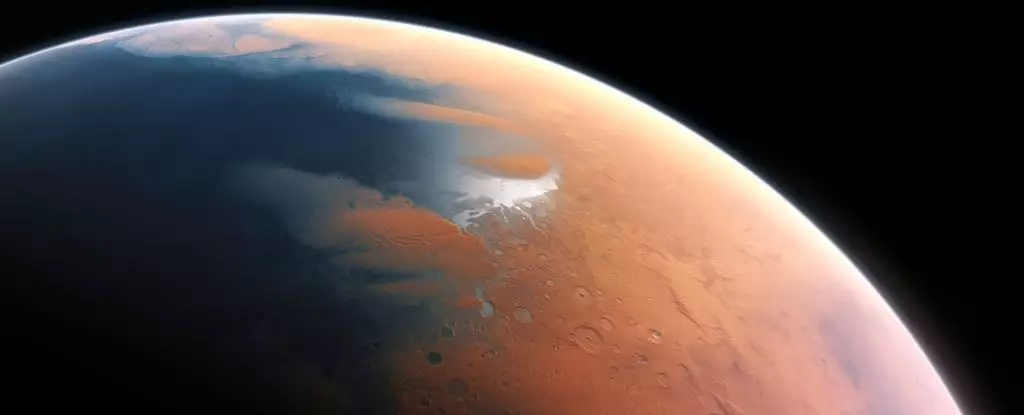The Red Planet has long captivated human imagination, not merely as a celestial sphere adrift in the cosmos but as a world steeped in mystery. With its ochre valleys, frozen poles, and cratered surface, Mars poses fundamental questions about its past. Once believed to be the site of grand rivers and shimmering lakes, the current barren landscape of Mars hints at profound geological transformations that occurred after its ancient climate regressed into inhospitable dryness. The dichotomy between Mars’ dynamic history and its present desolation paints a picture of a planet that has endured dramatic shifts, raising queries about the fate of its water—once abundant, now elusive.
Recent exploration, particularly via NASA’s InSight mission, has provided unprecedented insight into this query. By tapping into the seismic whispers of Mars through an advanced seismometer, scientists have begun to reveal a startling possibility: a vast reservoir of liquid water existing deep beneath the Martian crust. This finding could reshape our understanding of the planet and its habitability potential.
Seismic Revelations: A Slow Awakening
Utilizing seismic data gathered from the InSight lander, researchers have identified intriguing seismic waves that seem to slow as they traverse a mysterious layer situated between 5.4 and 8 kilometers beneath the surface. This phenomenon raises the tantalizing possibility that liquid water, potentially accumulated over billions of years, lies hidden in the porous rocks of the Martian crust, akin to a sponge steeped in water. Such a significant discovery not only sheds light on the historical presence of water on Mars but also hints at the implications for potential life—past, present, or future.
Speculations about where all the water went after Mars’ climate change abound. Calculations suggest that the “missing” water is substantial enough to inundate the planet in an ocean reaching depths of 700 to 900 meters. Existing theories point towards various possible fates for this water: it could have escaped into space, been trapped within frozen polar caps, or even integrated into mineral structures. However, the evidence supporting substantial quantities of liquid water trapped beneath the surface reframes the narrative entirely, offering a new lens through which we can view Mars’ transformation over eons.
The Life Beneath: Could Microbial Relics Exist?
The history of water on Mars does not merely feed into geological curiosity; it sets the stage for life as we understand it. On Earth, microbial life thrives in the depths of our planet, where water seeps into porous rock structures. The existence of similar microbial life forms in Martian aquifers remains a compelling hypothesis worth exploring. If such stations of life are indeed present, they could drastically change our understanding of life’s resilience in the cosmos.
Envisioning future human exploration of Mars, these liquid reservoirs could offer not just insights into ancient ecosystems but also practical resources for future colonists. The ability to harness purified water from below the surface could provide a vital supply for drinking, oxygen production, and even rocket fuel. Turning these theoretical frameworks into reality, however, necessitates addressing enormous technical challenges, including the logistics of drilling kilometers down into the alien terrain.
Catalysts for Future Exploration
The seismic data gathered near Mars’ equator hints at the potential for additional water-laden zones across the planet. This insight sets forth an urgent call for continued exploration missions equipped with seismometers that can systematically map the Martian crust for hidden reservoirs. Future rovers or drilling technology could play pivotal roles in accessing these underground aquifers and analyzing their chemical composition—perhaps revealing not only water but also potential bio-signatures.
But with the urge to uncover more about Mars comes the moral obligation to preserve it. These hidden oases must be protected from terrestrial microbes, as any contamination could thwart efforts to study Martian life forms, whether they exist or not. The exploration of Mars evolves not just as a scientific endeavor but as a responsibility to safeguard the integrity of another world.
The Promising Path Forward
As researchers continue to listen closely to Mars’ seismic rumblings, the unfolding narrative of the Red Planet grows richer and more complex. The emergence of potential water reservoirs beneath its surface invites a re-framing of Mars not solely as a contiguous desert but as a world replete with secrets—ready to be deciphered. With the evidence of liquid water, Mars transforms from a ghostly remnant of a once-thriving world into a robust candidate for exploration. This beckons all of humanity to participate in its story, extending our reach far beyond Earth and into the visceral depths of the cosmos. The quest for knowledge and understanding of life beyond our planet lies tantalizingly within reach; we must remain steadfast and vigilant as we continue the exploration of Mars, a journey into the heartbeat of a world that may harbor more than just dust and desolation.


Leave a Reply